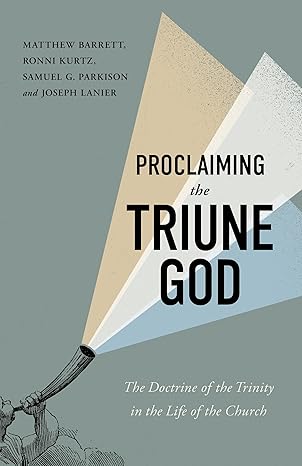A Book Review from Books at a Glance
by Ryan M. McGraw
A great gulf often exists between well-researched academic presentations of the Trinity and books aimed at the average Christian. Both in terms of organization and content, deeper studies of the Triune God often differ widely from popular studies, both in terms of organization and content. Seemingly creating two Trinitarian worlds, in one world scholars speak the language of divine simplicity, processions, subsistent relations, perichoresis, processions, missions, appropriations, and inseparable operations. In the other world of those in the pew, there is simply one God in three persons, and the Father, Son, and Spirit are each God without being each other somehow. Those inhabiting both worlds have trouble communicating with visitors from the other, with scholars bypassing ordinary believers who are struggling to know what to do with the Trinity. Beholding the Triune God is thus a translation project, teaching believers and pastors the rich language of historic Trinitarian theology in ways that help people see the relevance of the Trinity to seeing God in Scripture and worshiping him joyfully. This makes this book a great entry-level text for people wanting to go deeper into the Trinity and its implications without drowning in the process.
In six chapters, the authors aim to shape Trinitarian thinking from the ground up. Chapter 1 seeks to alert readers to rediscover both the meaning and centrality of Nicene Trinitarian theology to the Christian faith. Aiming at instruction, humility, and worship (26), they set a good tone for rediscovering Trinitarian ideas that most readers might not know that they were missing. Building on this material, chapter 2 illustrates how God reveals himself in human salvation, both by writing himself into the story of the gospel, and by saving from the Father, through the Son, in the Spirit. Divine simplicity, which teaches that God is not composed of parts but that all that is in God is God, follows in chapter 3, to the end that readers view the divine persons as integral to God rather than as parts of God. Chapters 4 and 5 are twins, introducing the processions of the Son and Spirit in terms of eternal generation and spiritation. Chapter six, on “inspirable operations,” shows that communion with God always entails knowing all three persons acting in us at once, without negating their appropriate works and properties. In this reviewer’s opinion, appropriations often get short-changed in modern Trinitarian thought. Making appropriations merely correlative to, or a subset of, inseparable operations seems to prioritize the unified action of God over biblical emphases on each person in ways that reflect their eternal personal properties. Rather than saying that appropriations are a corollary to inseparable operations (161), I would rather say that these two Trinitarian concepts qualify and illuminate each other. Yet the authors note well that appropriations fittingly reflect ad intra relations in God, showing who God is through what he does. They add that inseparable operations correspond to essential properties, while appropriations reflect personal properties (164). To illustrate in my own terms, all three persons love believers because God is essentially love and all three persons are God. Yet it is appropriate to associate love with the Father in election because the Father is origin of the Trinity, with the Son in redemption because he is from the Father and effects every divine work, and with the Spirit because he perfects God’s works by bringing love home to our hearts. While the authors could single out appropriations more fully, they eventually land in the right place.
Proclaiming the Triune God does something few Trinity books aimed at a broad audience do. The authors retain clarity and precision while achieving understandability and readability. Chapter content does not readily reveal the sermonic form in which the authors claim to have presented them originally, but this book can help readers nonetheless start a journey on the path of Trinitarian theology that is well-marked and easy to follow. This is a good book for those wanting to dig deeper than Sunday school, or to move beyond common reductions of the Trinity in nineteenth and twentieth century theological textbooks. Hopefully, readers will walk away knowing God more deeply and wanting to share the riches of God himself with others.
Ryan M. McGraw
Greenville Presbyterian Theological Seminary
